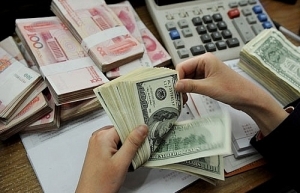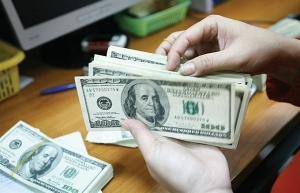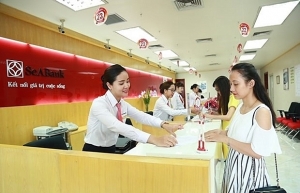Previous financial crises thus far averted via stable moves
The State Bank of Vietnam (SBV) last week adjusted the USD to VND exchange rate from ± 3 per cent to ± 5 per cent.
Economist Le Xuan Nghia said that the threshold of the foreign currency market had been at ± 5 per cent in the past to create a wide trading space up to a 10 per cent margin, so the move was not hugely significant.
“Due to the unstable issues in the 2008/2009 financial crisis, the SBV lowered the amplitude to ± 3 per cent. However, the rise of the central rate is the key point, while the amplitude widening is not particularly special,” said Nghia.
 |
| In the third quarter, the SBV adjusted selling rates three times at 3 per cent to VND23,925, Photo: Le Toan |
The domestic foreign exchange market has witnessed sharp movements in recent years – for example, the USD/VND exchange rate increased by 2.4 per cent in the third quarter. The unfavourable movement of the international environment was the main factor putting pressure on the domestic exchange rate.
The US Federal Reserve has continuously hiked the basic interest rate, by 150 points in the third quarter. Besides this, the cash flow is paying more attention to the US dollar as a safe currency amid the Russia-Ukraine conflict, the energy crisis in the Eurozone, and the nascent global recession.
Domestic foreign currency supply has continued a negative trend since the beginning of the year, with an estimated deficit of nearly $10 billion in the third quarter, while foreign currency demand tended to increase strongly.
Economist Nghia said that this context was not the same as the economic crisis in 2008 that broke the banking system and that the recovery would come soon if everything became stable and the value of the US dollar would fall a little.
“The increase of the central exchange rate and the adjustment of the exchange rate band by the SBV is also in line with the general trend of other currencies, but at very light adjustment. The VND depreciated by about 7 per cent, much lower than other countries thanks to the policies of the SBV,” said Nghia.
In the third quarter, the SBV adjusted selling rates three times at 3 per cent to VND23,925 and sold foreign currency to the market, at about $9 billion. The VND-USD swap rate difference also rose sharply to around 2 per cent.
The adjustment is deemed to benefit exporters and maintain the stability of the current account, while importers can be negatively affected.
With the Fed likely to continue strong tightening, raising the operating interest rate by about 125 points to around 4.4 per cent, the chance of a recession in the Eurozone is increasing due to the energy shortage crisis.
Moreover, domestic supply and demand are unlikely to improve soon because the demand for foreign currency sends profits back home to other countries, loan repayment tends to increase at year-end, and risks from the international environment are large enough for businesses and individuals to hold US dollars.
A BIDV leader expects that the increase of the domestic exchange rate will slow down thanks to the flexible regulatory policies of the SBV. “The SBV will try to stabilise the market and hold the exchange rate by not letting it rise too high. The VND-USD interest rate differential will likely continue to be moderated to a positive level with the expectation at around 2.5-3.5 per cent for the average of one-week term,” he said.
Economist Nghia added, “The US dollar has been going up consecutively for a year, its index has increased by 16-17 per cent, and the value of the US dollar has appreciated against others. US dollar has been on top and now poses a danger to the US economy, so experts predict that the US dollar will depreciate and cannot increase further.”
Even if the US raises interest rates and the rise of the US dollar slows and then goes down, the exchange rate will fluctuate between 7-8 per cent by the end of the year.
 | Exchange rates rise, credit stationary Exchange rates for both the central bank and other commercial banks rose slightly in February, while the credit sector showed little significant change, said the National Financial Supervisory Commission (NFSC). |
 | Volatility returns to foreign exchange rates On May 29 the State Bank of Vietnam adjusted the đồng-US dollar exchange rate, weakening the Vietnamese currency by VND9 to VND22,605 per dollar, which represented the greenback’s biggest rise so far this year. |
 | Bank lending rates expected to fall in 2020 A report by securities firm SSI on the financial and monetary market says deposit interest rates are likely to be cut by 0.5- 1 percentage point this year, and lending interest rates would also be cut by at least 0.5 percentage points as required by the Government. |
What the stars mean:
★ Poor ★ ★ Promising ★★★ Good ★★★★ Very good ★★★★★ Exceptional
Related Contents
Latest News
More News
- Securing capital and efficiency for Vietnam’s 2026-2030 growth ambitions (December 17, 2025 | 10:00)
- Energy sector in need of blended finance mechanisms (December 17, 2025 | 09:00)
- Vietnam still has room to mobilise capital for sustainable growth (December 17, 2025 | 08:57)
- Long-term capital seen as key hurdle to green growth (December 16, 2025 | 08:00)
- Gold prices swing amid tax debate and import uncertainty (December 15, 2025 | 18:04)
- Agribank frames bank credit as catalyst for green growth (December 15, 2025 | 17:59)
- Vietnam’s green transition demands collective financial action (December 15, 2025 | 12:00)
- VIR workshop highlights capital and policy for sustainable development (December 15, 2025 | 11:00)
- Promoting digital assets initiative in Vietnam (December 13, 2025 | 09:30)
- Experts flag gaps as national financial strategy under review (December 12, 2025 | 15:13)

 Tag:
Tag:






















 Mobile Version
Mobile Version